- Submissions

Full Text
Strategies in Accounting and Management
Testing Workplace Incivility with Adaptation Effects as Quantitative Research: A Case Study
Amna Hasnat1, Sundas Naqeeb Khan2*, Shazeena1 and Samrah Urooj Khan3
1Department of Information Technology, University of the Punjab, Jhelum Campus, Pakistan
2Faculty of Computer Science and Information Technology, Universiti Tun Hussein Onn Malaysia (UTHM), Malaysia
3Faculty of Electrical and Electronic Engineering, Universiti Tun Hussein Onn Malaysia (UTHM), Malaysia
*Corresponding author: Sundas Naqeeb Khan, Faculty of Computer Science and Information Technology, Universiti Tun Hussein Onn Malaysia (UTHM), Malaysia
Submission:July 27, 2022Published: August 19, 2022

ISSN:2770-6648Volume3 Issue4
Abstract
The purpose of this study is to investigate the causes and consequences of workplace incivility, with a focus on its positive and negative effects on workplace adaptation and incivility parameters. To do this, data is collected from banking staff in Jhelum and Sohawa districts of Pakistan using a quantitative approach while the data is analyzed statistically. Confirmatory factor analysis is used to analyze the data using AMOS 21. Path analysis is used to investigate the connection between workplace adaptation and incivility. After statistically controlling for the various demographic factors, people with a high level of negative effect and a low degree of establishing relationships with co-workers and supervisors are more likely to be uncivil. Workplace incivility can lead to decreased productivity and morale. Workplace adaptation adequate the effects of incivility and improve organizational performanc
Introduction
Facing interpersonal stressors at the workplace, such as rude customers, co-workers, or an angry supervisor, may be a fact of life for most employees [1]. Nevertheless, studies indicate that when employees frequently face such noxious aspects of the work environment, they become less happy and less able to focus on their job tasks. Workplace incivility is a form of interpersonal mistreatment typically characterized by a lack of courtesy, rudeness, and a lack of regard for others in violation of norms for mutual respect [2]. In one estimate, incivility at the workplace can cost businesses $14,000 a year per employee as a result of distractions with work and project delays. Whereas preceding research has exerted considerable effort toward examining incivility and its work-related outcomes, research focusing on moderators of incivility targets’ reactions to incivility is scarce in the literature [3]. Having one’s opinion ignored, being excluded from a meeting, and having one’s credibility undermined in front of others all these experiences fall under the lens of workplace incivility. Such uncivil behavior may be easily dismissed as subtle and trivial, yet it is ubiquitous within the workforce [4]. It is important to understand how incivility might affect organizations and employees; decade has largely focused on the incivility targets and their work or health outcomes. It has also been argued that workplace incivility may function as a means of asserting power but little empirical work has examined the relative power status of the instigator and targets its relationship with different incivility outcomes [5,6]. Workplace incivility is ubiquitous. It has been estimated that 98 percent of workers experience incivility, with 50 percent experiencing such conduct at least weekly. The monetary cost of experiencing incivility is very high per employee annually, due to project delays and cognitive distraction from work [7,8]. Workplace incivility has received increased attention from both practitioners and researchers within service industries because of its frequency and magnitude of its impact. A series of recent snapshots suggest a growing awareness of this phenomenon as a social problem of the first rank. American President George Bush signed up to support the ‘Framework for Civility’ declaration developed by the ‘Interfaith Alliance. This formal statement calls for ‘promoting civility, mutual respect and cooperation in our increasingly diverse society [9].
Research Contribution
Here first of all, the research question is presented for the ease for study. Is workplace adaptation a significant predictor of workplace incivility? So, the main objective of this research is to analyze the impact of workplace adaptation as a predictor of workplace incivility.
Literature Review
Socialization is a learning procedure during which the necessary expertise and facts for one’s job are acquired. This process is inspired by the need to resolve job-related doubts and skills through curiosity-induced, information-seeking actions such as asking queries, detecting and referring to others, and thinking as stated by [10]. Socialization is important in helping the person successfully adjust to the people and culture of an organization [11]. Organizational socialization mentions the process by which newcomers make the transition from being organizational outsiders to being insiders [12]. This proposed that employees acquire information and adjust to new jobs, parts, work groups, and the culture of the organization through this process in order to contribute well as an organizational associate [13]. There are numerous contexts to study adaptation such as social approaches [14], individual difference approaches by [15,16], and process approaches [17]. Socialization factors have usually followed one of the three approaches that influence new-comer adjustment structural, individualistic, and interaction [18-22]. This reported that objective fit is measured by likening person and environment variables as reported by different sources [23]. Some researchers studied the effects of incivility at various points in time. For example, Totterdell employed a diary methodology to study the effects of workplace incivility over time, and Meier and Spector studied incivility longitudinally over a five-wave 8-month time frame [24,25]. Other domains that assess incivility (e.g., the group norm level and the organizational level) also show effects on theory-driven outcome variables, such as job satisfaction and turnover intentions [26,27]. Moreover, other methodologies for studying consequences of uncivil conduct, such as by experimental manipulation or as captured by the critical incident methodology showed relationships with theoretically relevant outcomes, such as performance, retaliation, and helpfulness [28,29]. Some researchers do specifically assess both co-worker instigated and supervisor-instigated incivility [30-32]. This relatively little about whether incivility from different sources (supervisor, co-worker, and customer) would lead to different outcomes, even though status and role differentials may in fact influence the severity and content of the impact and the manner in which targets react to the uncivil incident [33].
Methodology
This section provides an illustration of the response in which the quantitative data analysis approach is properly defended. It will also disclose the data’s reliability and validity methodologies. As a result, workplace adaption and affective states are critical to the structure. The assessment of workplace adaptation is a measure of organizational socialization. A 1-factor model was used in this study to test a confirmatory factor analysis of selected factors. The criteria for removing items is based on the element loadings and remaining estimations for each item. The factor loadings of >.30 or greater is chosen to hold the item, while the standard estimation of every remnant is chosen to erase the item (Brown, 2006). “I know how to accomplish my job in this organization.” and “I know who of my coworkers is most likely to be able to answer my queries appropriately.” are two examples of items from the scale. On a 5point Likert scale ranging from 1 to 5, respondents stated how much they agreed with each question, with Cronbach’s alpha values of 0.96, 0.86, and 0.85 reported by Reio and Wiswell [10]. As a result, Figure 1 depicts a factor model for workplace adaptation.
Figure 1: Factors Model of workplace adaptation.

The PANAS is used to measure the negative and positive effects (Watson, Clark, Tellegen, 1998). Participants are asked to rate how often they experienced 10 good and 10 negative emotions at work during the time period under consideration. The response options ranged from 1 (strongly disagree) to 5 (completely agree). “Active, determined, attentive, and thrilled” is examples of positive effects, while “irritable, apprehensive, and afraid” are examples of negative effects. The Positive Effects (PE) scale had a reliability range of 0.86 to 0.90, whereas the Negative Effects (NE) scale had a reliability range of 0.84 to 0.87. Figure 2 & 3 shows the graphical representations of the factor model of positive and negative state effects, respectively. The factors are validated using AMOS 21 and confirmatory factor analysis. Bennett and Robinson’s 7-item scales of interpersonal (2000) are used to measure incivility in Pakistan’s banking sector, and the construct of workplace incivility is made up of 7 items adapted from incivility instigation. To obtain the results in this study, a confirmatory factor analysis evaluation in the form of a model is attempted. The criteria for excluding items are based on variable loadings and residual calculations for each item. Factor loading of >.30 or higher is chosen to keep the item, while 2.80 is picked as the typical estimate of the remaining items to remove them (Brown, 2006). Model of workplace incivility is described in Figure 4.
Figure 2: 1-Factors Model of positive effects.

Figure 3:1-Factors Model of negative effects.

Figure 4: 1-Factors Model of workplace incivility.

For data analysis, a statistical technique for data screening is used. Data screening is critical because it ensures that the data acquired during the field survey is of sufficient quality to pass through the different analyses and tests required to answer the study’s hypotheses. It would be of little use if it offered only speculative solutions (Davies, 2005; Meyers et al., 2006).
Results and Discussion
Relationship of workplace adaptation with workplace incivility
Workplace incivility dampens the socialization-related learning
required to adjust to the association since representatives are
more averse to looking for the data they require from colleagues
and managers because of the absence of correspondence. The
success of organizational socialization will rely on the openness
of correspondence of predominate sub-ordinates, encouraging the
connection between bosses and partners, understanding the part
(work) and hierarchical duty, and particularly the strategies of
organizational socialization.
H1: Workplace Adaptation predicts uncivil significantly.
Sample description
Table 1 demonstrates the sample description of employee demographics (age, gender, sector, qualification, and establishment size) from public and private banks of Jhelum and Sohawa districts of Punjab, Pakistan. Further information is obtained on the job tenure, 7.1% of employees are in the organization for less than one year.
Table 1:Demographic Description of Participants.
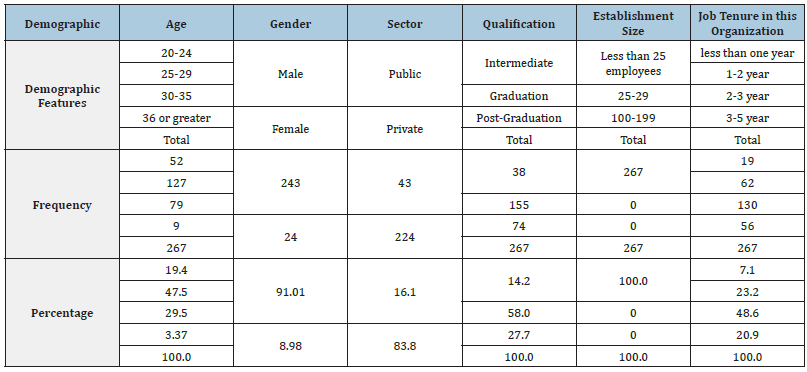
Correlations of variables
The mean value of workplace adaptation is 1.76 close to 2 which means the majority of the respondents disagreed and .635 is the standard deviation of workplace adaptation which shows 63.5% variation among responses. Moreover, workplace adaptation is negatively and significantly correlated (r = -.37**) with workplace incivility, at P<.01. The mean value of positive effects is 2.02 close to 2 which mean the majority of the respondents agreed and .928 is the standard deviation of positive effects which shows 92.8% variation among responses. The mean value of negative effects is 2.79 close to 3 which the majority of the respondents are neutral and .988 is the standard deviation of negative effects which shows 98.8% variation among responses. Moreover, negative effects positively and significantly correlated (r = .48**) with workplace incivility at P<.01. The mean value of workplace incivility is 3.05 close to 3 in which the majority of the respondents are neutral and .544 is the standard deviation which shows a 54.4% variation among responses. According to Table 2, all the measurements is presented along the effects numerically
Table 2:Means, Standard Deviation, and Pearson’s Moment Correlation..
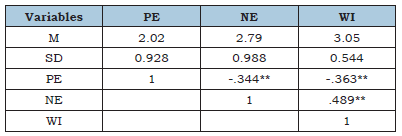
*P<.05; **P<.01; M= Mean; SD= Standard Deviation; PE= positive effects; NE= negative effects; WI= workplace incivility.
Effective experience
In the current study, a confirmatory factor analysis is tested in the form of a 1-factor model to better understand it. The factor loadings >.30 or above is chosen to hold the item while ± 2.80 is chosen the standard estimation of every leftover to erase the items (Brown, 2006). Model is tested and the criteria for eliminating the item is set on the basis of factor loadings and residual values of each item. A single factor model of positive effects is tested as shown in Table 3 and all 10 items are loaded on a single factor. After model specification, all the items having factor loading less than .30 are eliminated and residuals are correlated as modification indices guided. The range of standardized factor loadings in single factor model is from .49 to .57 which is in fairly adequate and over the set criterion for holding the items. Table 4 is illustrated all the retained items of positive effects.
Table 3:Confirmatory Factor Analysis of positive effects.
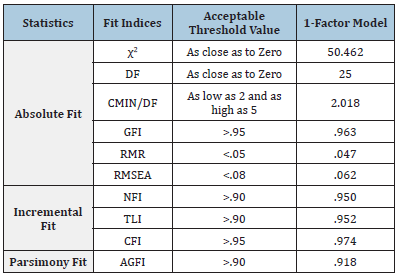
χ2 =Chi-square; DF= Degree of Freedom; CMIN= Minimum Chi-square; GFI= Goodness of fit index; RMR= Root Mean Square Residual; RMSEA= Root Mean Square Error of Approximation; NFI= Normed Fit Index; TLI= Tucker Lewis Index; CFI= Comparative Fit Index; AGFI= Adjusted Goodness of Fit Index
Table 4:Retained Items of positive effects.
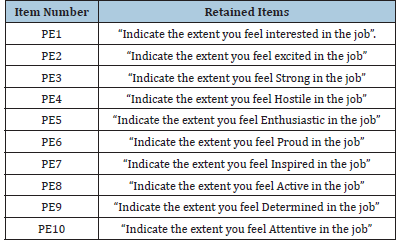
The components of negative effects are affirmed through CFA by utilizing AMOS 21. In the present review, a CFA is tested in the shape of a single model to comprehend it. Factor loading >.30 or above is chosen to hold the item while ± 2.80 is chosen as the standard estimation of every remaining to erase the items (Brown, 2006). The model is tried and the criteria for taking out the item are determined on the premise of variable loadings and residual estimations of each item. A single factor model of negative effects is tested and all 10 items are loaded on a single factor. After model specification, all the items having factor loading less than .30 are eliminated and residuals are correlated as modification indices guided. The results of the single factor model are dramatically extremely good and the Chi-square value is also in the good range as shown in Table 5. The values of the goodness of fit index are χ2=62.023, GFI=.953, CFI= .972, RMR= .043 and RMSEA .063. A single factor model is used to study the testing of negative effects. The range of standardized factor loadings in the single factor model is .37-.70 which is quite acceptable as shown in Figure 4. Table 6 is demonstrated all the retained items of negative effects.
Table 5:Confirmatory Factor Analysis of negative effects.

χ2 =Chi-square; DF= Degree of Freedom; CMIN= Minimum Chi-square; GFI= Goodness of fit index; RMR= Root Mean Square Residual; RMSEA= Root Mean Square Error of Approximation; NFI= Normed Fit Index; TLI= Tucker Lewis Index; CFI= Comparative Fit Index; AGFI= Adjusted Goodness of Fit Index.
Table 6:Retained Items of Negative Effects.
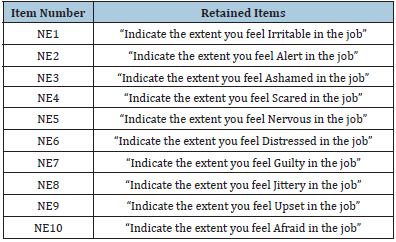
Workplace incivility
An endeavour is made to test a single factor model of workplace incivility and each of the 7 items is stacked on a single component. The criteria to remove items are determined to the premise of variable loadings and residual estimations of every item. The value of goodness of fit record are χ2/df= 8.792(4) and remaining items like GFI=987, CFI=992, RMR=029 and RMSEA=067 as appeared in Table 7 is also excellent. The Table 8 is represented the workplace incivility items in details.
Table 7:Confirmatory Factor Analysis of workplace incivility.
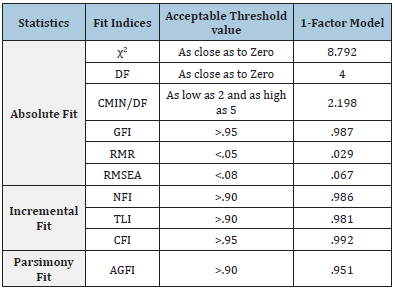
χ2 =Chi-square; DF= Degree of Freedom; CMIN= Minimum Chi-square; GFI= Goodness of fit index; RMR= Root Mean Square Residual; RMSEA= Root Mean Square Error of Approximation; NFI= Normed Fit Index; TLI= Tucker Lewis Index; CFI= Comparative Fit Index; AGFI= Adjusted Goodness of Fit Index.
Table 8:Retained Items of workplace incivility.
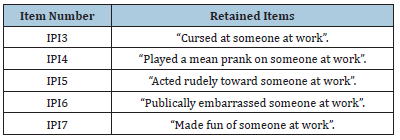
Conclusion
Workplace incivility is subtle and unclear, but it may be extremely damaging to a company. It is therefore critical to take appropriate measures to prevent incivility from spreading. The researcher tries to show in this study that demographics (age, gender), workplace adaption, and its effects all influence workplace incivility. To reduce workplace incivility, bank HR departments must clearly define workers’ opinions of what should be considered disrespectful in the workplace and assist in the development of a common organizational perception of what constitutes workplace incivility. Furthermore, people with more negative effect and less workplace adaption are more likely to engage in uncivil behavior, especially if they did not form favorable relationships with their coworkers. On the other hand, positive effect and workplace adaption increased the risk of high job stress and withdrawal behavior. Furthermore, more negative effects, less adaption, and more uncivil behavior are all linked to increased job stress and withdrawal behavior among employees. According to these findings, which are consistent with organizational socialization theory, employee collaboration and interconnection are vital for becoming effectively socialized in an association.
Limitations of the Study
The current study, like many other investigations, has limitations. The study tried to address a wide variety of characteristics that influence workplace incivility among banking employees. The current study’s findings are limited to two areas in Punjab, Pakistan (Jhelum and Sohawa). For a better understanding, it should be discussed at the divisional level. The current research is quantitative in nature. Qualitative research may also help in better understanding the causes of incivility. Researchers would benefit greatly from the development of new incivility measures that are both theoretically and psychometrically more rigorous. Because the researcher’s current study is cross-sectional, longitudinal studies could be valuable for tracking the impact of research factors on organizational results over time. It would be interesting to monitor newcomers for two years and see how uncivil behavior interacts with and influences their learning and socialization, as well as their long-term retention in the organization.
References
- Stroud LR, Tanofsky-Kraff M, Wilfley DE, Salovey P (2000) The Yale Interpersonal Stressor (YIPS): Affective, physiological, and behavioral responses to a novel interpersonal rejection paradigm. Annals of Behavioral Medicine 22(3): 204-213.
- Cole MS, Shipp AJ, Taylor SG (2016) Viewing the interpersonal mistreatment literature through a temporal lens. Organizational Psychology Review 6(3): 273-302.
- Milam AC, Spitzmueller C, Penney LM (2009) Investigating individual differences among targets of workplace incivility. Journal of occupational health psychology 14(1): 58-69.
- Berger BA (2000) Incivility. American Journal of Pharmaceutical Education 64(4): 445.
- Samma M, Zhao Y, Rasool SF, Han X, Ali S (2020) Exploring the relationship between innovative work behavior, job anxiety, workplace ostracism, and workplace incivility: Empirical evidence from Small and Medium Sized Enterprises (SMEs). Healthcare 8(4): 508.
- Cortina LM, Magley VJ, Williams JH, Langhout RD (2001) Incivility in the workplace: Incidence and impact. J Occup Health Psychol 6(1): 64-80.
- Cortina LM, Kabat-Farr D, Leskinen EA, Huerta M, Magley VJ (2013) Selective incivility as modern discrimination in organizations: Evidence and impact. Journal of management 39(6): 1579-1605.
- Schilpzand P, De Pater IE, Erez A (2016) Workplace incivility: A review of the literature and agenda for future research. Journal of Organizational behavior 37(Supp 1): S57-S88.
- Kim H, Qu H (2019) The effects of experienced customer incivility on employees’ behavior toward customers and coworkers. Journal of Hospitality & Tourism Research 43(1): 58-77.
- Reio TG, Wiswell A (2000) Field investigation of the relationship among adult curiosity, workplace learning, and job performance. Human resource development quarterly 11(1): 5-30.
- Taormina RJ (2009) Organizational socialization: The missing link between employee needs and organizational culture. Journal of Managerial Psychology 24: 650-676.
- Bauer MW, Knill C (2007) Management reforms in international organizations.
- Saks AM, Uggerslev KL, Fassina NE (2007) Socialization tactics and newcomer adjustment: A meta-analytic review and test of a model. Journal of vocational behavior 70(3): 413-446.
- Pulakos ED, Arad S, Donovan MA, Plamondon KE (2000) Adaptability in the workplace: Development of a taxonomy of adaptive performance. J Appl Psychol 85(4): 612-624.
- Ployhart RE, Bliese PD (2006) Individual adaptability (I-ADAPT) theory: Conceptualizing the antecedents, consequences, and measurement of individual differences in adaptability. In Understanding adaptability: A prerequisite for effective performance within complex environments. Emerald Group Publishing Limited.
- Griffin MA, Neal A, Parker SK (2007) A new model of work role performance: Positive behavior in uncertain and interdependent contexts. Academy of management journal 50(2): 327-347.
- George JM, Jones GR (2001) Towards a process model of individual change in organizations. Human relations 54(4): 419-444.
- Bauer TN, Bodner T, Erdogan B, Truxillo DM, Tucker JS (2007) Newcomer adjustment during organizational socialization: A meta-analytic review of antecedents, outcomes, and methods. Journal of applied psychology 92(3): 707-721.
- Saks AM, Ashforth BE (1997) Organizational socialization: Making sense of the past and present as a prologue for the future. Journal of vocational Behavior 51(2): 234-279.
- Gruman JA, Saks AM, Zweig DI (2006) Organizational socialization tactics and newcomer proactive behaviors: An integrative study. Journal of vocational behavior 69(1): 90-104.
- Goparaju L, Jha CS (2010) Spatial dynamics of species diversity in fragmented plant communities of a Vindhyan dry tropical forest in India. Tropical Ecology 51(1): 55-65.
- Kim TY, Cable DM, Kim SP (2005) Socialization tactics, employee proactivity, and person-organization fit. Journal of Applied Psychology 90(2): 232.
- Billsberry J, Talbot D, Hollyoak B (2011) The social construction of PE Fit. Academy of Management Journal 61(4).
- Totterdell P, Hershcovis MS, Niven K, Reich TC, Stride C (2012) Can employees be emotionally drained by witnessing unpleasant interactions between coworkers? A diary study of induced emotion regulation. Work & Stress 26(2): 112-129.
- Meier LL, Spector PE (2013) Reciprocal effects of work stressors and counterproductive work behavior: A five-wave longitudinal study. Journal of Applied Psychology 98(3): 529-539.
- Walsh MA, Royal AM, Barrantes-Vidal N, Kwapil TR (2012) The association of affective temperaments with impairment and psychopathology in a young adult sample. Journal of affective disorders 141(2-3): 373-381.
- Griffin MJ, Abergel A, Abreu A, Ade PA, André P, et al. (2010) The Herschel-SPIRE instrument and its in-flight performance. Astronomy & Astrophysics 518 (L3): 7.
- Giumetti GW, Hatfield AL, Scisco JL, Schroeder AN, Muth ER, et al. (2013) What a rude e-mail! Examining the differential effects of incivility versus support on mood, energy, engagement, and performance in an online context. Journal of occupational health psychology 18(3): 297-309.
- Sallmyr A, Fan J, Datta K, Kim KT, Grosu D, et al. (2008) Internal tandem duplication of FLT3 (FLT3/ITD) induces increased ROS production, DNA damage, and misrepair: Implications for poor prognosis in AML. Blood 111(6): 3173-3182.
- Leiter B (2010) American legal realism. A companion to philosophy of law and legal theory, pp. 249-266.
- Leiter MP, Laschinger HKS, Day A, Oore DG (2011) The impact of civility interventions on employee social behavior, distress, and attitudes. J Appl Psychol 96(6): 1258-1274.
- Leiter MP, Day A, Oore DG, Spence Laschinger HK (2012) Getting better and staying better: Assessing civility, incivility, distress, and job attitudes one year after a civility intervention. Journal of occupational health psychology 17(4): 425-434.
- Hershcovis MS, Barling J (2010) Towards a multi‐foci approach to workplace aggression: A meta‐analytic review of outcomes from different perpetrators. Journal of organizational Behavior 31(1): 24-44.
© 2022 Sundas Naqeeb Khan. This is an open access article distributed under the terms of the Creative Commons Attribution License , which permits unrestricted use, distribution, and build upon your work non-commercially.
 a Creative Commons Attribution 4.0 International License. Based on a work at www.crimsonpublishers.com.
Best viewed in
a Creative Commons Attribution 4.0 International License. Based on a work at www.crimsonpublishers.com.
Best viewed in 







.jpg)






























 Editorial Board Registrations
Editorial Board Registrations Submit your Article
Submit your Article Refer a Friend
Refer a Friend Advertise With Us
Advertise With Us
.jpg)






.jpg)














.bmp)
.jpg)
.png)
.jpg)










.jpg)






.png)

.png)



.png)






